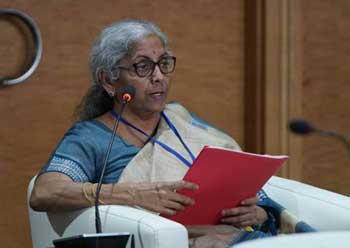In a significant statement made during the third edition of the Kautilya Economic Conference, Finance Minister Nirmala Sitharaman highlighted the government’s strategic plans to elevate the per capita income of Indians by an impressive $2,000 over the next five years. This initiative is not just about numbers; it aims to dramatically enhance the standard of living for millions of citizens across the nation.
A Vision for Doubling Per Capita Income
The Finance Minister articulated that, according to the International Monetary Fund (IMF), it took India 75 years to reach a per capita income of $2,730. However, under the current government’s policies, the addition of $2,000 to this figure is expected within a much shorter timeframe. She asserted, “This will truly be the era of Indians,” signaling a period of unprecedented growth and opportunity.
Tackling Global Challenges with Resilience
Despite the numerous global challenges, India, with its population of 1.4 billion—representing 18% of the world’s population—is determined to double per capita income. Minister Sitharaman’s confidence reflects the underlying strength of the Indian economy and its capacity to adapt and thrive amidst adversity.
Significant Reduction in Inequality
One of the most promising developments highlighted by the Finance Minister is the reduction of income inequality in India. The Gini coefficient, a statistical measure used to gauge income distribution, has shown improvements in both urban and rural sectors. In rural areas, the Gini coefficient has decreased from 0.283 to 0.266, while in urban areas, it has dropped from 0.363 to 0.314. This reduction is a strong indicator of the government’s commitment to promoting equitable economic growth.
Towards a Developed India by 2047
Minister Sitharaman projected a prosperous India by 2047, the centenary of its independence, when the country will embody characteristics similar to those of developed nations. She emphasized that this new Indian era will not only enrich the lives of its citizens but also contribute significantly to global prosperity through a vibrant exchange of ideas, technologies, and cultures.
Strengthening the Financial Framework
The Finance Minister underscored the importance of a robust financial system as the backbone of the country’s economic progress. She mentioned improvements in asset quality, increased provisions for bad debts, and a sustained focus on capital adequacy and profitability. The non-performing asset (NPA) ratio is at its lowest in years, thanks to improved recovery mechanisms in the banking sector.
These enhancements in the financial framework are critical for maintaining the stability necessary to support growth and investment across various sectors of the economy.
Empowering the Youth: The Driving Force
India’s demographic advantage lies in its youthful population, with 43% of its citizens under the age of 24. This demographic is expected to drive productivity improvements, savings, and investments, laying a solid foundation for future economic growth. The Finance Minister noted that this youthful populace is still in the process of shaping its consumption behavior, indicating a significant surge in domestic consumption in the coming decade.
Strategic Measures for Economic Advancement
To support the ambitious target of increasing per capita income, the government has laid out a comprehensive set of strategies:
1. Infrastructure Development
Investment in infrastructure is pivotal to enhancing economic capabilities. The government has launched initiatives to upgrade transportation networks, boost energy production, and improve digital connectivity. These developments will facilitate smoother business operations and enhance overall productivity.
2. Support for Small and Medium Enterprises (SMEs)
Recognizing the vital role that SMEs play in the economy, the government is implementing policies to provide easier access to credit and resources. This empowerment will stimulate job creation and drive innovation, significantly impacting economic growth.
3. Fostering Innovation and Technology
The emphasis on innovation and technology is evident in government initiatives aimed at fostering a thriving startup culture. By encouraging research and development, India is positioning itself as a leader in technological advancements and innovation.
4. Attracting Foreign Investment
To attract foreign direct investment (FDI), the government has simplified regulations and introduced incentives for global businesses. This influx of capital is crucial for boosting domestic industries and enhancing productivity.



















